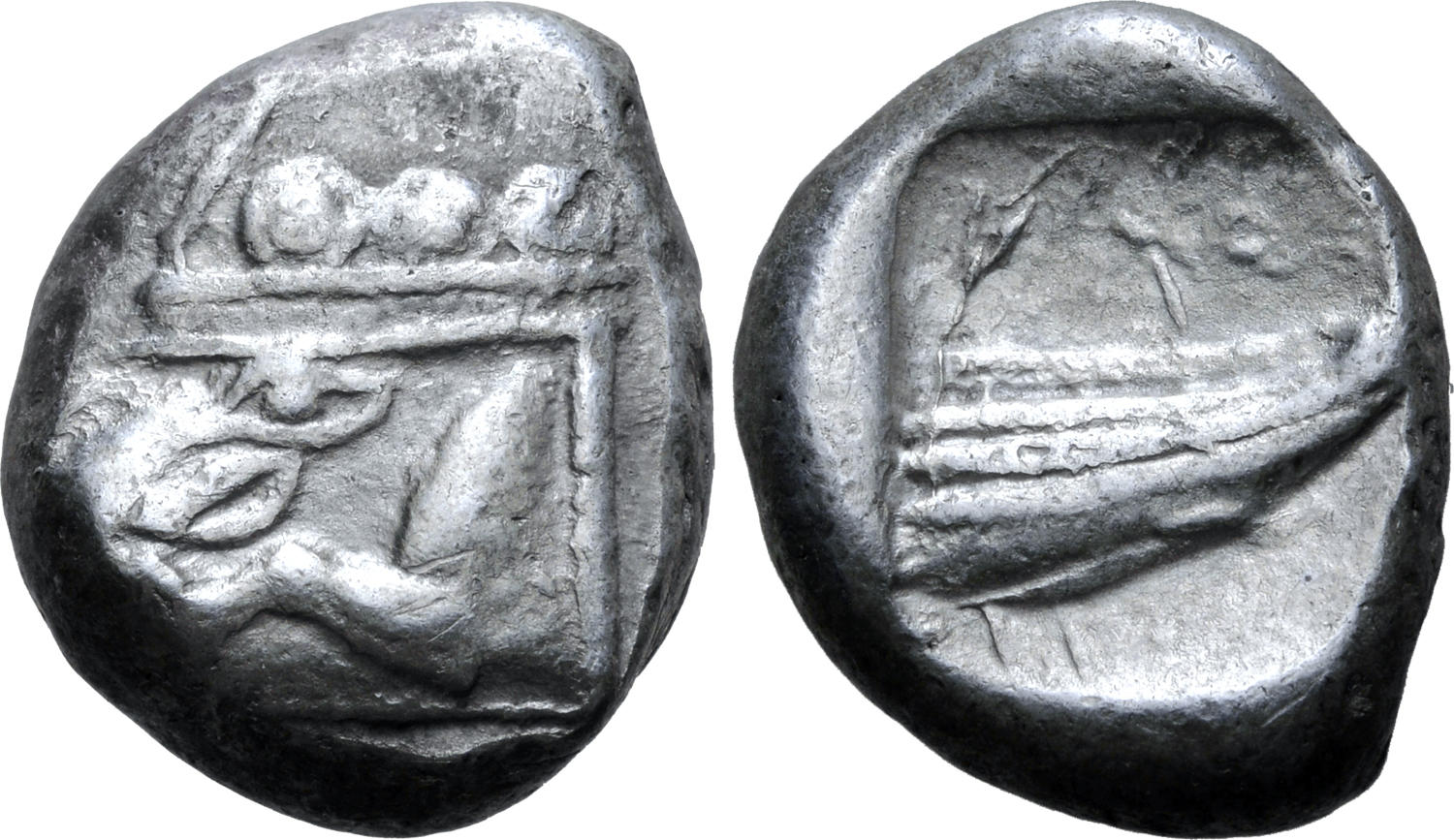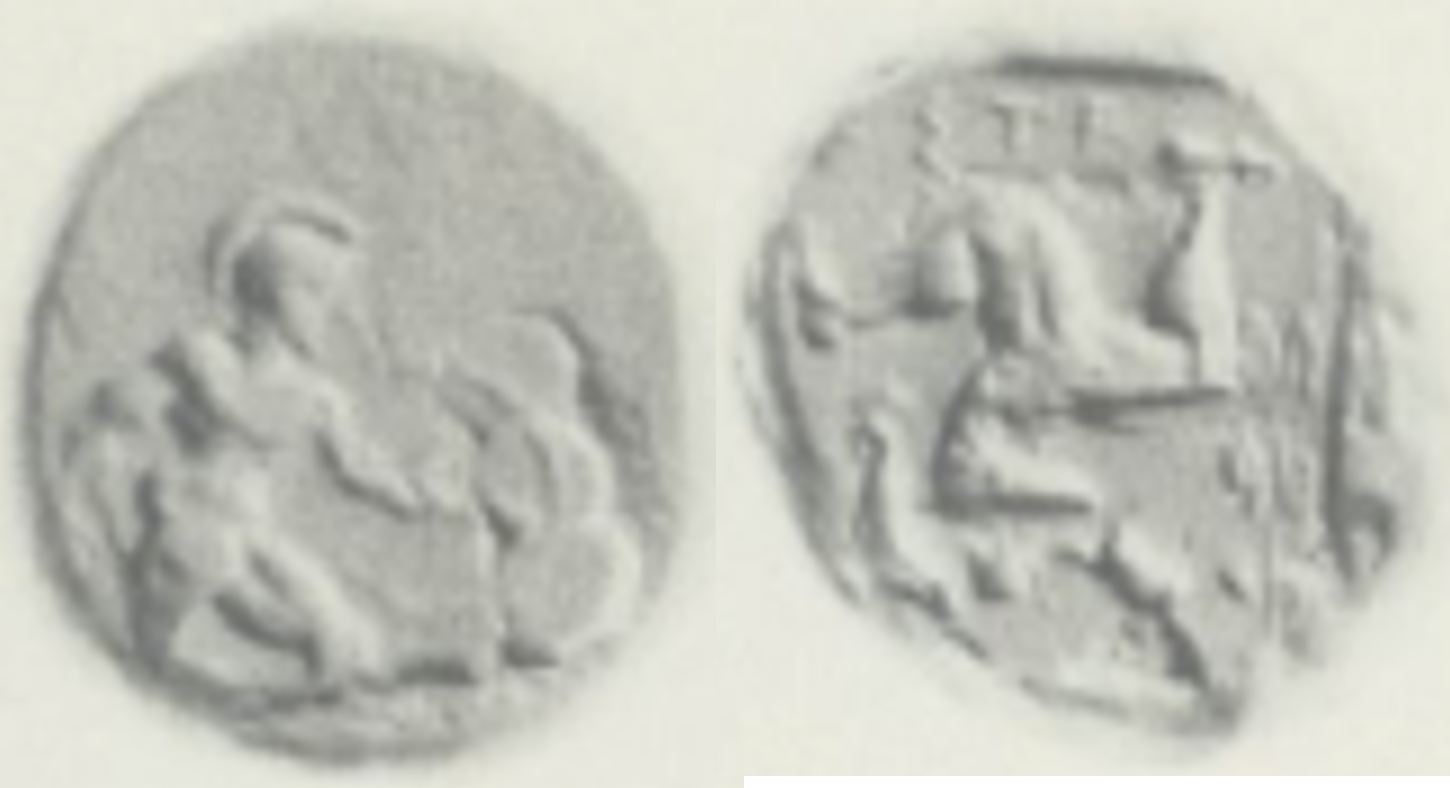2360 - Aspendus (double siglos hoplite/triskeles) over Phaselis (prow/incuse square) (Kraay 1969, pl. XVI, 2)
From SILVER
463 BCE - 430 BCE | ΕΣΤ
Images
Overstruck variety

Phaselis 3 globules.jpg [1]
Location/history
| Sale(s)Sale(s) ᵖ: | Spink | |
Overstriking coin
Description
| ObverseInscription or printing placed on the obverse.: | Warrior walking right, naked, wearing helmet, holding spear in right hand, shield attached on left arm. | ReverseInscription or printing placed on the reverse.: | ΕΣΤ (Greek) Triskeles of human legs within incuse square. Rooster to left in left field. Branch of laurel in right field. |
Mint and issuing power
| MintIdentifies the place of manufacture or issue of a numismatic object.: | Aspendus | Ancient regionAncient region. | Pamphylia | Modern countryModern country: Turkey | AuthorityIdentifies the issuing power. The authority can be "pretended" when the name or the portrait of X is on the coin but he/she was not the issuing power. It can also be "uncertain" when there is no mention of X on the coin but he/she was the issuing power according to the historical sources: | Persian Empire |
Chronology
| FromIdentifies the initial date in a range assigned in a numismatic context. 463 BCE toIdentifies the final date in a range assigned in a numismatic context.. 430 BCE | Classical 480-323 BC |
Physical description
| MetalThe physical material (usually metal) from which an object is made.: Silver |
DenominationTerm indicating the value of a numismatic object. Examples: tetradrachm, chalkous, denarius.: double siglos |
||
| StandardStandard.: Persian | |||
References
| Coin referenceReference of the Coin: | Kraay 1969, p. 15-16, n° 6, 1, pl. XVI, n° 2, Callataÿ 2018b, p. 138, n° 1 | Coin series referenceReference to coin series study: | BMC Lycia1BMC Lycia, Aspendos, p. 94, n° 8, Babelon 1901-19322Babelon 1901-1932, Tome 1, Part 2, p. 526-530, n° 862, SNG Copenhagen Lycia-Pamphylia3SNG Copenhagen Lycia-Pamphylia, n° 177-178, Kraay 19694Kraay 1969, p. 15-16, n° 6, 1, pl. XVI, n° 2, SNG von Aulock Pamphylien5SNG von Aulock Pamphylien, n° 4481, SNG France 36SNG France 3, n° 11, Callataÿ 2018b7Callataÿ 2018b, p. 138, n° 1 |
| Coin series web referenceCoin series web references: | |||
Overstruck type
Description
| ObverseInscription or printing placed on the obverse.: | Prow terminating in a boar’s forepart, with 3 shields | ReverseInscription or printing placed on the reverse.: | ΦAΣ (Greek) Stern of galley to right, all within incuse square |
Mint and issuing power
| MintIdentifies the place of manufacture or issue of a numismatic object. ᵖ: | Phaselis | Ancient regionAncient region. ᵖ | Lycia | Modern countryModern country: Turkey | AuthorityIdentifies the authority in whose name (explicitly or implicitly) a numismatic object was issued. ᵖ: | Persian Empire |
Chronology
| FromIdentifies the initial date in a range assigned in a numismatic context. 520 BCE toIdentifies the final date in a range assigned in a numismatic context.. 500 BCE | Archaic until 480 BC |
Physical description
| DenominationTerm indicating the value of a numismatic object. Examples: tetradrachm, chalkous, denarius. ᵖ: | stater |
References
| Coin type referenceReference to coin series study ᵖ: | SNG von Aulock Lykien8SNG von Aulock Lykien, 4391, Heipp-Tamer 19939Heipp-Tamer 1993, n° 3 | ||
| Coin series web reference overstruckCoin series web references overstruck: | |||
Additional data
| Frequency of overstrikesFrequency of overstrikes: | frequent | Level of confidenceLevel of confidence of the identification: | sure |
| RemarksRemarks: | |||
References
- ^ Hill, George Francis (1897), A Catalogue of the Greek coins in the British Museum. vol. XVIII : Lycia, Pamphylia, Pisidia, London, The Trustees, p. 353, pl. 44.
- ^ Babelon, Ernest (1901-1932), Traité des monnaies grecques et romaines, Paris, E. Leroux
- ^ Breitenstein, Niels (1955), Sylloge Nummorum Graecorum: Royal Collections of coins and medals. Danish National Museum, 31, Lycia-Pamphylia.
- ^ Kraay, Colin M. (1969), "Fifth century overstrikes at Rhegium and Messana", in La circolazione della moneta ateniese in Sicilia e in Magna Grecia : atti del I Convegno del Centro internazionale di studi numismatici, Napoli, 5-8 aprile 1967, Roma, p. 141-150, pl. 12.
- ^ Sylloge Nummorum Graecorum. Sammlung v. Aulock. Pamphylien. 11 Heft (n° 4477-4893), Berlin, 1965.
- ^ Levante, Edoardo [with the collaboration of Peter Weiss] (2001), Sylloge nummorum graecorum. France. 3, Département des monnaies, médailles et antiques : Pamphylie, Pisidie, Lyaconie, Galatie, Paris-Zürich, Bibliothèque nationale de France-Numismatica Ars Classica, XXXIV + 293 p. and 146 pl.
- ^ Callataÿ, François de (2018), “Overstrikes on Pamphylian and Cilician silver sigloi (5th-4th c. BC)”, in O. Tekin (ed.), Proceedings of the Second International Congress of the Anatolian Monetary History and Numismatics in the Mediterranean World, 5-8 January 2017 Antalya, Antalya, 2018, p. 131-150.
- ^ Sylloge Nummorum Graecorum. Sammlung v. Aulock. Lykien. 10 Heft (n° 4041-4876), Berlin, 1964.
- ^ Heipp-Tamer, Christine (1993), Die Münzprägung der lykischen Stadt Phaselis in griechischer Zeit, Saarbrücken, 182 p., 32 pl.
